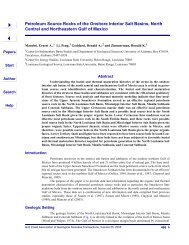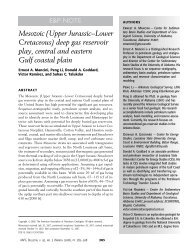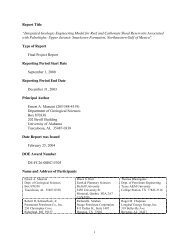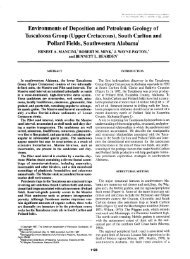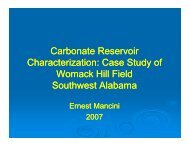Part 4 - Berg - Hughes Center
Part 4 - Berg - Hughes Center
Part 4 - Berg - Hughes Center
Create successful ePaper yourself
Turn your PDF publications into a flip-book with our unique Google optimized e-Paper software.
Pine Island shale, averaging 250 ft in thickness, is widely distributed in Arkansas and<br />
Louisiana and located in the subsurface between 4,000 and 7,000 ft. Minor production<br />
has been reported from its basal Causey, Hogg and Woodruff sandstone reservoirs<br />
(Breedlove et al., 1953; Crump, 1953; Whitfield, 1963). The first well drilled in the Pine<br />
Island found gas and salt water in a sandstone from 5,315 to 5,340 ft at the base of the<br />
formation, but the second in the Causey sandstone was the first commercial gas producer.<br />
Net pay of the reservoir sandstone ranges from 30 to 60 ft with porosity of 10 to 15% and<br />
permeability from 10 to 200 md. Hydrocarbons produced are typically 24º to 30º API<br />
gravity oil, condensate, and gas.<br />
James Formation<br />
Producing Parishes<br />
Bossier, Webster, Claiborne, Lincoln<br />
De Soto, Bienville, Jackson<br />
The James Formation (late Aptian age) overlies the Pine Island Shale and was<br />
deposited in a moderately low energy open shelf environment. The James consists of<br />
burrowed argillaceous miliolid lime mudstone, wackestone, and packstone (Yurewicz<br />
et al., 1993). According to Forgotson (1957), the term “James limestone" was first<br />
applied in the year 1926 to a section of calcareous sandstone that was cored in Union<br />
Parish, Louisiana, from 3,827 to 3,917 ft. Forgotson (1957) described the James as sandy<br />
and chalky, fossiliferous limestone, fine- to medium-grained, and calcareous sandstone<br />
with gray shale interbeds. However, its lithology is quite variable throughout the region,<br />
changing westward to black marl and shale in northwest Louisiana and northeast Texas.<br />
In southwest Arkansas, the James consists of a fossiliferous, dense limestone and red and<br />
368




